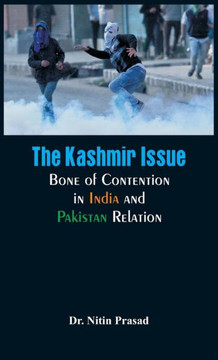
Alpha Edition
Kashmir : A Centre of India-Pakistan Dispute Need Balance Solution
Product Code:
9789352977307
ISBN13:
9789352977307
Condition:
New
$50.00
$44.32
Sale 11%
The Kashmir dispute dates from 1947. The partition of the Indian sub-continent along religious lines led to the formation of India and Pakistan. However, there remained the problem of over 650 states, run by princes, existing within the two newly independent countries. The Line of Control (LOC) between India and Pakistan is perhaps the most dangerous place in the world. Both India and Pakistan have their own political reasons for continuing the fighting. Although the ruler of Jammu and Kashmir, Hari Singh, was an Indian, most of his subjects were Muslims. War was averted when India and Pakistan agreed to a plebiscite to decide the fate of Kashmir. There were delays in implementing this decision, however, and increasingly it became clear that the Indians wanted to keep that portion which contained Jamu and Kashmir. Despite numerous United Nations resolutions the dispute remained unsettled. Pakistan argued that Kashmir should become a part of Pakistan because the majority of its inhabitants were Muslims. The Indians claimed, without proof, that Kashmiris wanted to remain a part of India. In 1972 Indira Gandhi, the Indian prime minister, and Zulfikar Ali Bhutto, her Pakistani opposite number (and father of Benazir Bhutto, a later Pakistani premier), signed the Simla Agreement, which reiterated the promises made in Tashkent. The two sides once again agreed to resolve the issue peacefully, as domestic issues dominated. Both India and Pakistan had other important domestic problems which kept Kashmir on the back-burner. In a diverse country like India, disaffection and discontent are not uncommon. Indian democracy has the necessary resilience to accommodate genuine grievances within the framework of our sovereignty, unity and integrity. Government of India has expressed its willingness to accommodate the legitimate political demands of the people of the state of J&K. However, Pakistan sponsored terrorists have terrorised the population and hindered political dialogue by intimidating or silencing voices of moderation that wish to engage in dialogue. The human rights of the people of J&K have been systematically violated by such terror tactics and the kidnappings and killings of innocent people by terrorists. Every effort has been taken to make this book useful for students of conflict resolution scholars and general readers.
| Author: Nitin Prasad |
| Publisher: Alpha Edition |
| Publication Date: Jun 16, 2018 |
| Number of Pages: 286 pages |
| Language: English |
| Binding: Hardcover |
| ISBN-10: 9352977300 |
| ISBN-13: 9789352977307 |

Kashmir : A Centre of India-Pakistan Dispute Need Balance Solution
$50.00
$44.32
Sale 11%
The Kashmir dispute dates from 1947. The partition of the Indian sub-continent along religious lines led to the formation of India and Pakistan. However, there remained the problem of over 650 states, run by princes, existing within the two newly independent countries. The Line of Control (LOC) between India and Pakistan is perhaps the most dangerous place in the world. Both India and Pakistan have their own political reasons for continuing the fighting. Although the ruler of Jammu and Kashmir, Hari Singh, was an Indian, most of his subjects were Muslims. War was averted when India and Pakistan agreed to a plebiscite to decide the fate of Kashmir. There were delays in implementing this decision, however, and increasingly it became clear that the Indians wanted to keep that portion which contained Jamu and Kashmir. Despite numerous United Nations resolutions the dispute remained unsettled. Pakistan argued that Kashmir should become a part of Pakistan because the majority of its inhabitants were Muslims. The Indians claimed, without proof, that Kashmiris wanted to remain a part of India. In 1972 Indira Gandhi, the Indian prime minister, and Zulfikar Ali Bhutto, her Pakistani opposite number (and father of Benazir Bhutto, a later Pakistani premier), signed the Simla Agreement, which reiterated the promises made in Tashkent. The two sides once again agreed to resolve the issue peacefully, as domestic issues dominated. Both India and Pakistan had other important domestic problems which kept Kashmir on the back-burner. In a diverse country like India, disaffection and discontent are not uncommon. Indian democracy has the necessary resilience to accommodate genuine grievances within the framework of our sovereignty, unity and integrity. Government of India has expressed its willingness to accommodate the legitimate political demands of the people of the state of J&K. However, Pakistan sponsored terrorists have terrorised the population and hindered political dialogue by intimidating or silencing voices of moderation that wish to engage in dialogue. The human rights of the people of J&K have been systematically violated by such terror tactics and the kidnappings and killings of innocent people by terrorists. Every effort has been taken to make this book useful for students of conflict resolution scholars and general readers.
| Author: Nitin Prasad |
| Publisher: Alpha Edition |
| Publication Date: Jun 16, 2018 |
| Number of Pages: 286 pages |
| Language: English |
| Binding: Hardcover |
| ISBN-10: 9352977300 |
| ISBN-13: 9789352977307 |





